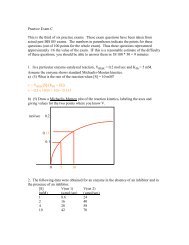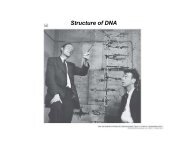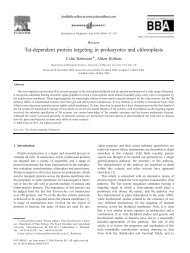The dual nature of homologous recombination in plants
The dual nature of homologous recombination in plants
The dual nature of homologous recombination in plants
- No tags were found...
You also want an ePaper? Increase the reach of your titles
YUMPU automatically turns print PDFs into web optimized ePapers that Google loves.
Review TRENDS <strong>in</strong> Genetics Vol.21 No.3 March 2005 175<strong>in</strong>teracted with both DMC1 and RAD51 <strong>in</strong> a yeast-twohybridanalysis. With the same technique <strong>in</strong>teractionswith<strong>in</strong> the RAD51 paralogs RAD51 and XRCC3, andbetween XRCC3 and RAD51C were detected [23]. Inagreement with these f<strong>in</strong>d<strong>in</strong>gs, xrcc3 mutant <strong>plants</strong>revealed severe meiotic defects and a sterility phenotype[24]. In contrast to the previously described mutants,synapsis <strong>in</strong> xrcc3 appeared to be unaffected and bivalentswere formed normally. As meiosis proceeded chromosomebridges and fragmentation were observed suggest<strong>in</strong>g adist<strong>in</strong>ct role <strong>of</strong> XRCC3 <strong>in</strong> a later phase <strong>of</strong> mHR; mostprobably, branch migration and resolution <strong>of</strong> Hollidayjunctions (HJ) are dependent on both XRCC3 andRAD51C [25].Some eukaryotic homologs <strong>of</strong> the bacterial mismatchrepair prote<strong>in</strong>s MutS and MutL are thought to promotethe crossover, branch migration and the resolution <strong>of</strong> theHJs <strong>in</strong> mHR. An Arabidopsis mlh1 mutant was describedthat lacked an obvious meiotic or somatic phenotype [26],although the <strong>nature</strong> <strong>of</strong> this allele did not permit a f<strong>in</strong>alconclusion. A mutation <strong>in</strong> the Arabidopsis MSH4 gene ledto a reduction <strong>of</strong> chiasmata number and to delayed and<strong>in</strong>complete synapsis result<strong>in</strong>g <strong>in</strong> univalents [27]. Thissupports a role <strong>of</strong> MSH4 <strong>in</strong> mHR, whereby it probablyacts <strong>in</strong> a heterodimeric complex with MSH5 as a slid<strong>in</strong>gclamp, keep<strong>in</strong>g together the <strong>homologous</strong> chromosomesengaged <strong>in</strong> HJs, as was recently proposed for the humanMSH4–MSH5 complex [28].An <strong>in</strong>terest<strong>in</strong>g aspect <strong>of</strong> plant meiosis is the lack <strong>of</strong> acheckpo<strong>in</strong>t, which controls the progression <strong>of</strong> meiosis,provok<strong>in</strong>g meiotic arrest <strong>in</strong> yeast and apoptosis <strong>in</strong>animals. All <strong>of</strong> the mutants described above proceedthrough meiosis despite conta<strong>in</strong><strong>in</strong>g aberrant chromosomefigures, enabl<strong>in</strong>g more extensive studies on meioticchromosome dynamics. Nevertheless, the Arabidopsishomolog <strong>of</strong> Ataxia Telangiectasia-Mutated (ATM), whichsignals from DSB to checkpo<strong>in</strong>t and repair pathways <strong>in</strong>other eukaryotes, was shown to be <strong>in</strong>volved <strong>in</strong> somaticDNA damage response and clearly has a function <strong>in</strong>meiotic <strong>recomb<strong>in</strong>ation</strong>; mutants <strong>in</strong> this gene reveal achromosome fragmentation phenotype similar to that <strong>of</strong>the xrcc3 mutant [29]. This suggests that ArabidopsisATM controls mHR at SPO11 <strong>in</strong>duced DSBs, but not the<strong>in</strong>tegrity <strong>of</strong> meiotic chromosomes.It is to be expected that more genes act<strong>in</strong>g <strong>in</strong> mHR willbe identified with time and that careful analyses <strong>of</strong>multiple mutations will decipher plant meiosis. For<strong>in</strong>stance, some <strong>of</strong> the mutants isolated <strong>in</strong> a screen forX-ray sensitivity had also changed levels <strong>of</strong> meiotic<strong>recomb<strong>in</strong>ation</strong> [30,31], but the genes responsible for thisphenotype have not been isolated yet (Table 2).Somatic <strong>recomb<strong>in</strong>ation</strong>DSBs are among the most dangerous forms <strong>of</strong> DNAdamage; a s<strong>in</strong>gle unrepaired DSB <strong>in</strong> yeast, even <strong>in</strong> adispensable gene, can result <strong>in</strong> cell death [32]. DSBs arecaused by both cell-external and <strong>in</strong>ternal factors: ioniz<strong>in</strong>gradiation is an example <strong>of</strong> an external factor, DNAreplication across a nick is an <strong>in</strong>ternal factor, whereasreactive oxygen species can accumulate <strong>in</strong> plant cells as aconsequence <strong>of</strong> pathogen attack and/or <strong>of</strong> <strong>in</strong>tr<strong>in</strong>sicmetabolic activities. Numbers are not available for <strong>plants</strong>,but it has been estimated that 5–10% <strong>of</strong> first passageprimary fibroblasts from mice or humans have a chromosomebreak (discussed <strong>in</strong> Ref. [33]). In <strong>plants</strong> andvertebrates most <strong>of</strong> these breaks are repaired by non<strong>homologous</strong>-endjo<strong>in</strong><strong>in</strong>g (NHEJ), an error-prone process.HR enables repair <strong>in</strong> a precise fashion. However, HR <strong>in</strong>somatic tissue is not only active <strong>in</strong> repair, but also <strong>in</strong>chang<strong>in</strong>g the copy number <strong>of</strong> genes, as is already evident<strong>in</strong> <strong>recomb<strong>in</strong>ation</strong> products orig<strong>in</strong>at<strong>in</strong>g from HR <strong>in</strong> transgenicmarker genes (see Figure I <strong>in</strong> Box 2). Repair willhave to be fast and efficient, whereas changes <strong>in</strong> copynumber will have to be modulated <strong>in</strong> a subtle way. <strong>The</strong>repair <strong>of</strong> DNA damage <strong>in</strong> somatic cells has to be understood<strong>in</strong> terms <strong>of</strong> the repair pathways <strong>in</strong>volved and <strong>in</strong>terms <strong>of</strong> modulation <strong>of</strong> these pathways as <strong>in</strong>fluenced bydevelopment and the environment.Box 2. Marker genes for assays <strong>of</strong> <strong>homologous</strong> <strong>recomb<strong>in</strong>ation</strong>Mapped phenotypic markers (such as color markers <strong>in</strong> maize kernelsor the classic pea markers used by Mendel) or molecular markers areusually employed for the analysis <strong>of</strong> mHR frequencies <strong>in</strong> <strong>plants</strong>,<strong>recomb<strong>in</strong>ation</strong> be<strong>in</strong>g assayed <strong>in</strong> the recomb<strong>in</strong>ant progeny. To enablethe measurement and visualization <strong>of</strong> somatic and meiotic HR eventsup to the resolution <strong>of</strong> a s<strong>in</strong>gle cell, special substrates were developed.<strong>The</strong> basis <strong>of</strong> the technique is the <strong>in</strong>sertion <strong>in</strong>to the plant genome(us<strong>in</strong>g Agrobacterium tumefaciens) <strong>of</strong> transgenes permitt<strong>in</strong>g selectableor screenable detection <strong>of</strong> HR events. Markers based on selection(for <strong>in</strong>stance <strong>in</strong>volv<strong>in</strong>g the creation by <strong>recomb<strong>in</strong>ation</strong> <strong>of</strong> antibioticresistance) are more difficult to use and require cell culture <strong>of</strong> planttissue (reviewed <strong>in</strong> Ref. [2]). <strong>The</strong> most valuable constructs enable theanalysis <strong>of</strong> HR at the plant level us<strong>in</strong>g a visible reporter. Such a systemwas recently developed, consist<strong>in</strong>g <strong>of</strong> an endogenous cluster <strong>of</strong>Ribulose-Bisphosphate-Carboxylase small subunit (RBCS) genes,one <strong>of</strong> which is fused to a promoterless Luciferase reporter gene(Figure Ia). Recomb<strong>in</strong>ation between the RBCS repeats enables theluciferase gene to switch from an <strong>in</strong>active state to an active screenablestate. This locus-specific <strong>in</strong>tegrated <strong>recomb<strong>in</strong>ation</strong> substrate can revealmeiotic <strong>in</strong>tergenic unequal cross<strong>in</strong>g-over between sister chromatids[66,67]. Moreover, somatic <strong>recomb<strong>in</strong>ation</strong> events, occurr<strong>in</strong>g <strong>in</strong> lateflower or very early embryo development, can also be identified.<strong>The</strong> analysis <strong>of</strong> HR <strong>in</strong> somatic plant tissue was previously restrictedto the use <strong>of</strong> ill-characterized natural systems [68,69]. <strong>The</strong> use <strong>of</strong> newmarker genes has revolutionized the research field with<strong>in</strong> the past15 years. Currently used reporter-based constructs consist <strong>of</strong> tandemrepeats <strong>of</strong> a disrupted b-glucuronidase (GUS) oraLuciferase (LUC)gene (Figure Ib–d; schemes shown for GUS). Different orientations,relative to each other, <strong>of</strong> the disrupted genes enable the scor<strong>in</strong>g <strong>of</strong><strong>in</strong>tramolecular (Figure Ib,c) or <strong>in</strong>termolecular HR events (Figure Id). Inthe second case a chromosomal homolog or a sister chromatid servesas <strong>recomb<strong>in</strong>ation</strong> partner [2,70]. <strong>The</strong>reby, different types <strong>of</strong> <strong>recomb<strong>in</strong>ation</strong>processes could lead to a functional reporter gene: pop-out,unequal reciprocal exchange and gene conversion [70], which is –shown <strong>in</strong> Figure Id – possibly the most frequent [71]. <strong>The</strong> structure <strong>of</strong>the <strong>recomb<strong>in</strong>ation</strong> substrate trap could not be designed to enable adist<strong>in</strong>ction between <strong>in</strong>terchromatid or <strong>in</strong>terchromosomal <strong>recomb<strong>in</strong>ation</strong>.Only the use <strong>of</strong> molecular markers flank<strong>in</strong>g the repeats <strong>of</strong> thedisrupted marker gene would permit this. It should be noted that <strong>in</strong><strong>plants</strong> conta<strong>in</strong><strong>in</strong>g the <strong>in</strong>tramolecular constructs (Figure Ib,c) HR canalso occur between sister chromatids and <strong>homologous</strong> chromosomesalthough at a lower frequency than expected for <strong>in</strong>tramolecular<strong>recomb<strong>in</strong>ation</strong>.www.sciencedirect.com








